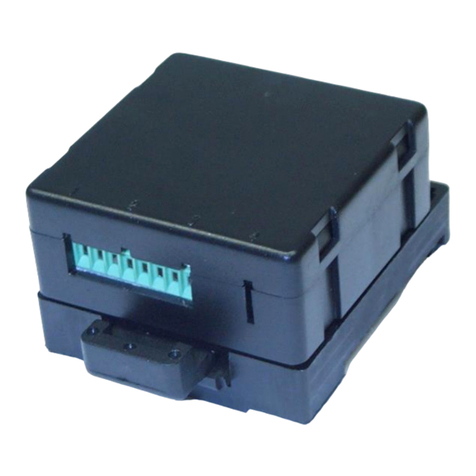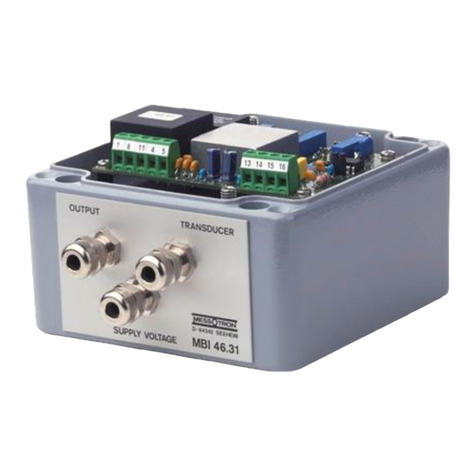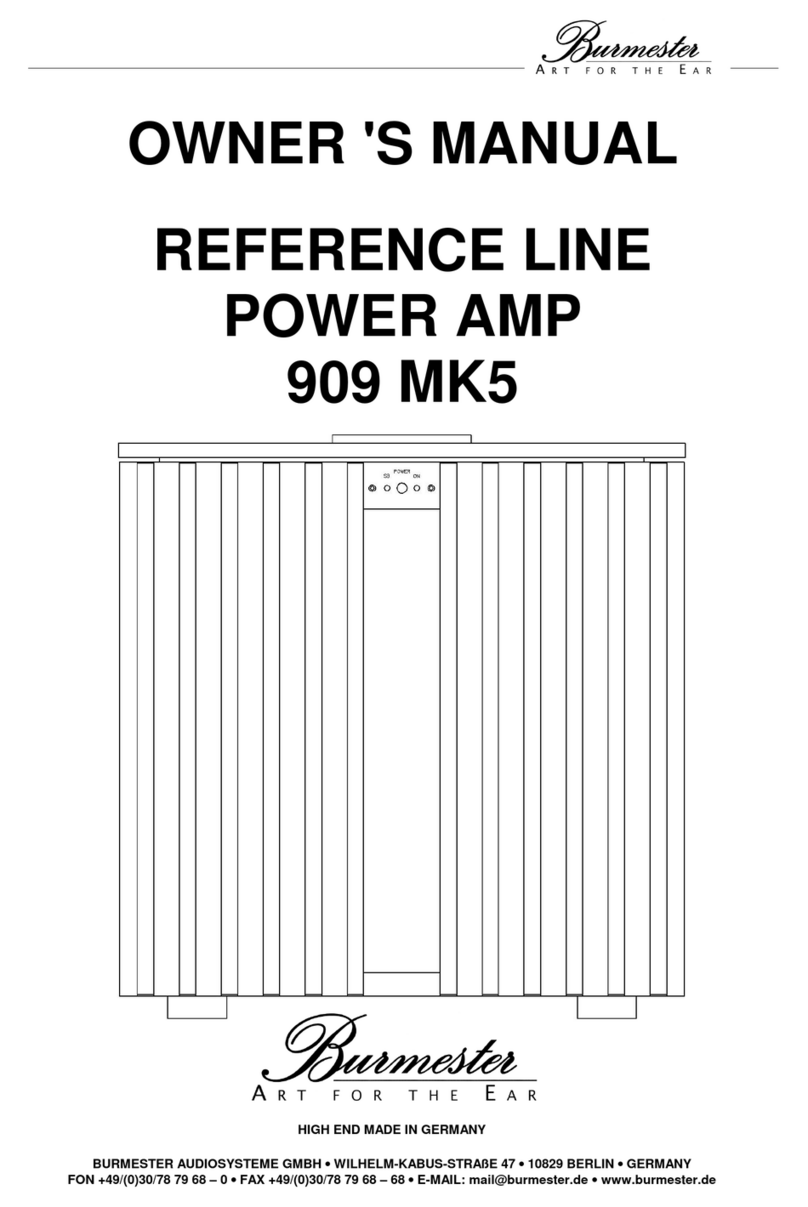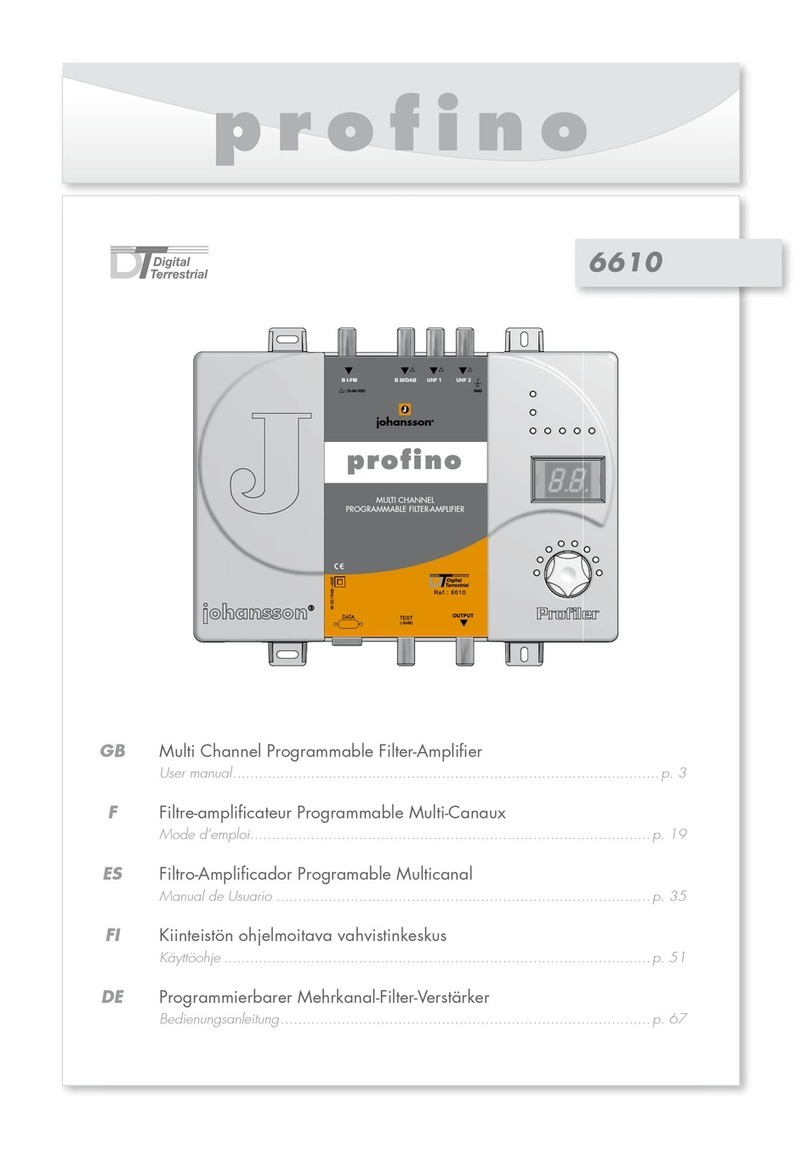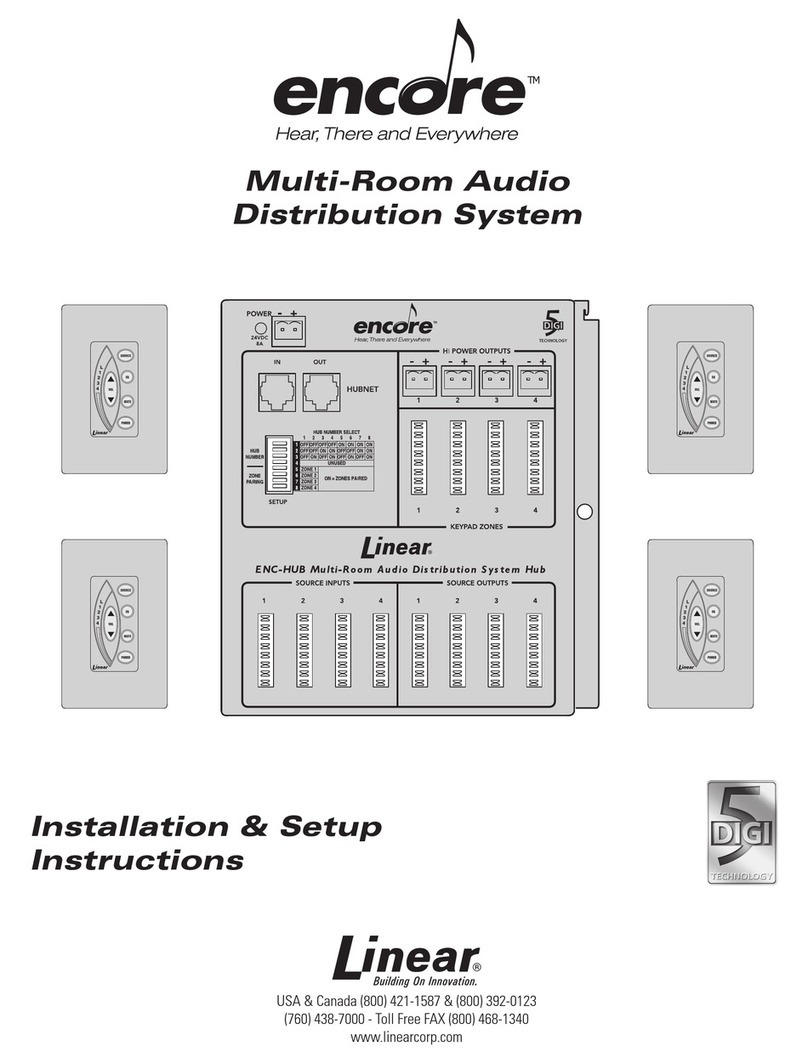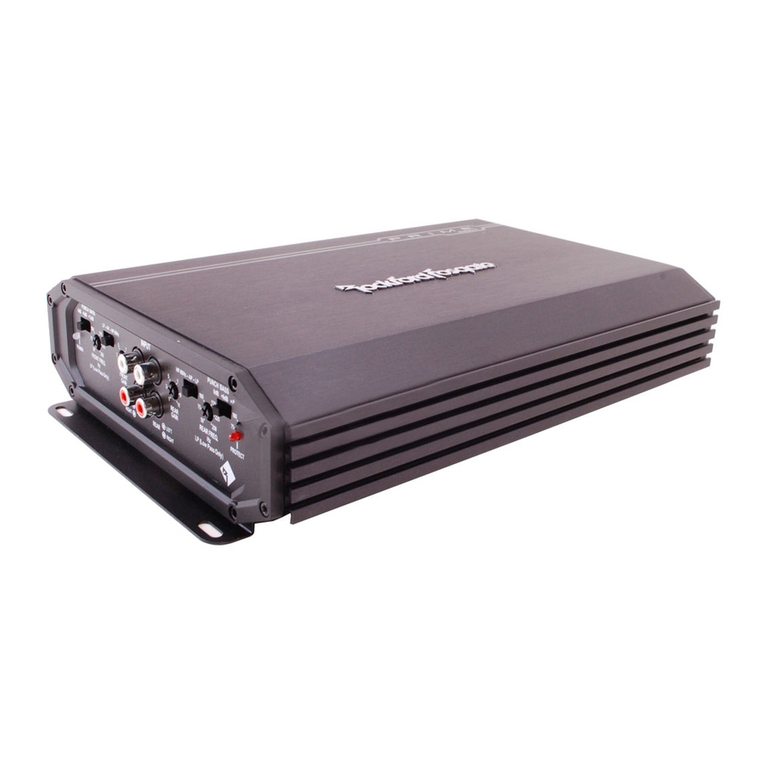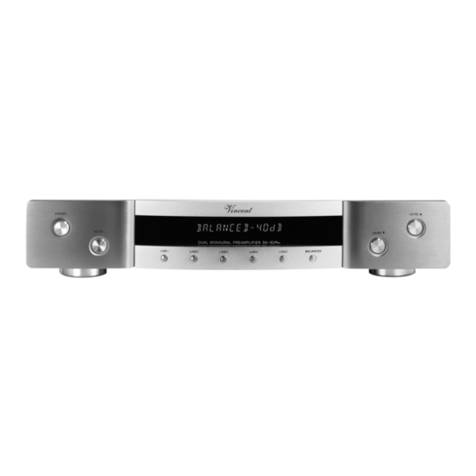Messotron MBI 46.51.39 Series User manual

Operating Instructions MBI 46.51.39
Version 0.9 en MBI 46.51.39 operating instructions.docx
Issue: 08/2022 page 1 from 29
Operating instructions for
Carrier Frequency Amplifier
Series MBI 46.51.39

Operating Instructions MBI 46.51.39
Version 0.9 en MBI 46.51.39 operating instructions.docx
Issue: 08/2022 page 2 from 29
Table of contents
1General........................................................................................................3
1.1 Warranty and liability.............................................................................3
1.2 Importance of Nameplate......................................................................3
1.3 Technical support and contact details...................................................3
2Safety...........................................................................................................4
2.1 Intended use.........................................................................................4
2.2 Site Conditions......................................................................................4
2.3 General hazards ...................................................................................4
2.4 Qualified personnel...............................................................................4
2.5 Transport damages...............................................................................4
3Warnings and markings.............................................................................5
3.1 Use of warnings....................................................................................5
3.2 Other markings .....................................................................................5
4Product........................................................................................................6
4.1 Terms and definitions............................................................................6
4.2 Function and design..............................................................................8
4.3 Suitable displacement transducers........................................................8
4.4 Types and options...............................................................................11
5Commissioning.........................................................................................13
5.1 Wiring Details / Pin Assignment ..........................................................14
5.2 Use with MESSOTRON transducers...................................................15
5.3 Setting and adjustment options...........................................................16
5.4 Setting of transducer type ...................................................................18
5.5 Adjustment of gain range....................................................................19
5.6 Adjustment of offset, gain and phase-shift...........................................19
5.7 Optimization of the linearity behavior ..................................................22
6Operation ..................................................................................................25
7Repair........................................................................................................25
8Maintenance..............................................................................................26
8.1 Maintenance .......................................................................................26
8.2 Cleaning..............................................................................................26
9Disposal ....................................................................................................26
10 EU Declaration of Conformity ...............................................................27
11 Specifications.........................................................................................27

Operating Instructions MBI 46.51.39
Version 0.9 en MBI 46.51.39 operating instructions.docx
Issue: 08/2022 page 3 from 29
1 General
Please read and follow these operating instructions carefully.
1.1 Warranty and liability
Any warranty and liability claim against MESSOTRON shall be lost if
•damage occurs due to non-observance of the operating instructions
•modifications have been made that are not documented in this manual
•nameplate has been removed from the device
1.2 Importance of Nameplate
The specification of the model type and the manufacturing number is required for repair and
for the procurement of subsequent deliveries and spare parts. Both information is given on the
nameplate.
Do not remove the nameplate from the device and handle with care.
1.3 Technical support and contact details
If you have any questions, please do not hesitate to contact us.
MESSOTRON GmbH & Co KG
Friedrich-Ebert-Str. 37
D-64342 Seeheim-Jugenheim
Germany
Phone:+49 (0) 6257 999 730
Email:inf[email protected]
Further information can also be found on the website www.messotron.com

Operating Instructions MBI 46.51.39
Version 0.9 en MBI 46.51.39 operating instructions.docx
Issue: 08/2022 page 4 from 29
2 Safety
2.1 Intended use
Use the MBI 46.51.39 carrier frequency amplifier exclusively for the operation of differential
transformers (LVDT) and inductive half-bridge displacement transducers (LVIT). The amplifier
may only be operated with passive transducers without built-in electronics. Any further use
shall be deemed not to be in accordance with its intended purpose.
In order to ensure proper and safe operation, the device must only be operated in accordance
with this instruction. Make sure to follow any applicable legal / safety regulation for the
respective use of application. This also applies to the use of accessories.
2.2 Site Conditions
Be sure that the site conditions for the intended installation are within the technical
specifications of the device e.g., in terms of temperature and IP protection etc.
Do not use the device near other machinery or devices such like large electrical machines,
high voltage cables and facilities that generate strong electric or magnetic fields.
2.3 General hazards
The device complies with the latest state-of-the-art technology and regulations and is safe
when used as intended. Residual hazards may emanate from the device if it is improperly used
and operated e.g., by insufficiently qualified personnel.
2.4 Qualified personnel
Both the commissioning and operation of the device may only be carried out by trained
professionals who are aware of the dangers at hand. Professionals must be familiar with
national health and safety regulations, accident prevention regulations and general industrial
standards for installation of electronic equipment.
2.5 Transport damages
Before unpacking, check the packaging of the device for any damages. If the packaging has
been damaged during transport and if there is a suspicion of damage to the device, it may not
be put into operation. Have MESSOTRON check the device before using it.

Operating Instructions MBI 46.51.39
Version 0.9 en MBI 46.51.39 operating instructions.docx
Issue: 08/2022 page 5 from 29
3 Warnings and markings
3.1 Use of warnings
For warnings, the following hazard classes are specified according to ANSI. Z 535 used:
Warning sign, signal word
Meaning
Indicates a dangerous situation in which death orserious
bodily injury occurs if it is not avoided.
Indicates a dangerous situation in which death orserious
bodily injury can occur if not avoided.
Characterizes a dangerous situation in which mild to
moderate bodily injuries can occur if not avoided.
Indicates possible property damage: The product or
environment can be harmed.
3.2 Other markings
Tips contain important information on how to get the most out of your device.
Disregarding a tip can result in incorrect measurement results.
WARNING
CAUTION
DANGER
HINT
TIP

Operating Instructions MBI 46.51.39
Version 0.9 en MBI 46.51.39 operating instructions.docx
Issue: 08/2022 page 6 from 29
4 Product
4.1 Terms and definitions
Term
Definition
Carrier frequency
measuring amplifier
Carrier frequency measuring amplifiers are used for LVDT/LVIT:
•to provide the inductive sensor with the excitation voltage
•to amplify the sensor output signal
•to convert the sensor output into a normalized signal
Displacement
sensor
In these instructions the term displacement transducer may also be
mentioned: sensor, transducers, or position sensors.
Differential
transformer
(LVDT)
Differential transformers consist of a primary coil and two secondary
coils placed around a movable magnetic core. The coils are coupled
based on the transformer principle. LVDT stands for “Linear Variable
Differential Transformer”.
Inductive half-
bridge transducer
(LVIT)
Differential inductors represent a Wheatstone half-bridge with two
measuring coils. The impedance of the two measuring coils is
influenced in opposite directions by a movable magnetic core. They are
also referred to as LVIT (Linear Variable Inductance Transducer).
Long-stroke
sensors based on
the eddy current
principle
Long-stroke sensors are inductive displacement sensors using a half-
bridge circuit, where only one coil is used for measuring. The second
coil is designed as a space-saving equivalent circuit. A movable tube
made of a conductive material changes the impedance of the measuring
coil based on the eddy current principle.
Symmetric sensor
The measuring coils of differential transformers and inductors are built
in a symmetrically (mirrored) design. The electrical zero is at the center
of the nominal stroke.
Asymmetric sensor
The space-saving equivalent circuit of the 2nd coil of the long-stroke
sensors results in an asymmetric design enabling a more favorable
stroke-to-length ratio. The electrical zero is at the start of the nominal
stroke, where the tube completely covers the measuring coil.
Core rod
The core rod is a cylindrical part consisting of
•a magnetic core
•a core extension
Measuring tube
The measuring tube is made of aluminum. In asymmetric displacement
sensors it is moved over the measuring coil drawing energy from the
coil field proportional to the tube’s position (eddy current effect).
Excitation voltage
AC voltage (typically 1...5 Vpp), supplying the inductive sensor.
Carrier frequency
Excitation frequency, usually 5 or 10 kHz, to drive the inductive
displacement sensor.

Operating Instructions MBI 46.51.39
Version 0.9 en MBI 46.51.39 operating instructions.docx
Issue: 08/2022 page 7 from 29
Term
Definition
Measuring voltage
Output signal proportional to the displacement (AC voltage in the mV
range) provided by the inductive displacement sensor.
Zero-point
At the electrical zero-point, the output signal of the displacement sensor
is zero. Refer to the data sheet of the displacement sensor for physical
position of the zero-point, see “measurement A”.
Rated output
(FSO)
The rated output of the sensor is defined as the ratio of the sensor
output voltage (measurement voltage) to the sensor input voltage
(excitation voltage) at the end of the nominal stroke. For calibrated
displacement sensors the rated output is e.g. 80 mV/V, independent of
the nominal stroke of the displacement sensor.
In older data sheets, the term “nominal output” may be used as well as
full scale output (FSO).
Sensitivity
The sensitivity is defined as the ratio of the measurement voltage to the
excitation voltage per mm of displacement (e.g. 10 mV/V/mm).
For standardization purposes information on sensitivity and rated output
for MESSOTRON displacement sensors is determined and provided
independent of phase (i.e. without consideration of a phase shift).
Phase (phase shift)
With inductive sensors and/or long connecting cables, there will be a
noticeable phase shift between the excitation voltage and the
measurement voltage. This phase shift lowers the (effective) sensitivity
of the sensor in the measuring chain.
All MESSOTRON series MBI 46.13 measuring amplifiers can
compensate a phase shift.
Linearity error
The linearity error of measuring devices is the maximum deviation
between the nominal characteristic (straight line) and the real
characteristic of the measuring device. The error information is
referenced to the total measuring range (FSO / Full Scale Output).
Nominal output
range
The nominal output range of themeasuring amplifier indicates the range
covered by the output signal, if the displacement sensor operates in the
(nominal) measuring range.
Voltage output
Analog voltage output of the measuring amplifier:
•typically ±10 V for symmetric displacement sensors
•typically 0-10V for asymmetric displacement sensors

Operating Instructions MBI 46.51.39
Version 0.9 en MBI 46.51.39 operating instructions.docx
Issue: 08/2022 page 8 from 29
4.2 Function and design
The MBI 46.51.39 carrier frequency amplifier generates an alternating excitation voltage
required for the operation of inductive displacement transducers. The carrier frequency is
typically 5 kHz, unless otherwise specified.
The output signal from the displacement transducer is pre-amplified by the measuring amplifier
and evaluated ratiometrically, i.e. in relation to the supply voltage. This avoids measurement
errors due to fluctuations in the supply voltage e.g., due to impedance change of the
displacement transducer or cables.
In the following stages, the measurement signal is filtered and scaled to the desired output
range for further processing.
4.3 Suitable displacement transducers
The device series can be used with a variety of inductive transducers. Further details may be
found in chapter 11 or in the respective datasheet.
For selection of suitable sensor / amplifier combination
•Type of displacement sensor (LVDT, LVIT, others)
•Wiring details of the sensor
•Required carrier frequency
•Excitation voltage
•Rated output / sensitivity
TIP

Operating Instructions MBI 46.51.39
Version 0.9 en MBI 46.51.39 operating instructions.docx
Issue: 08/2022 page 9 from 29
The electrical design of the three displacement transducer types offered by MESSOTRON is
described below.
4.3.1 Linear Variable Inductive Transducers (LVIT)
Electrically, a displacement transducer based on the differential inductor principle represents
a Wheatstone half-bridge consisting of two measuring coils. The core, which moves inside the
coils, causes in its middle position (electrical zero point) that both measuring coils have the
same impedance. The bridge circuit is thus balanced, the measuring voltage is zero.
Figure 1 Amplifier with Differential Choke
If the core is moved out of its middle position, the impedances of the two measuring coils
change and the measuring voltage grows proportionally within the measuring range
proportionally with the displacement of the core.
4.3.2 Linear Variable Differential Transformers (LVDT)
Differential transformers consist of one primary and two secondary coils, which are coupled via
a magnetic core according to the transformer principle.
The primary coil being fed with an AC voltage induces a voltage in the secondary coils. The
output is zero due to the counter-connection of these coils, when the core is in the middle
position.
If the core is moved out of its middle position, the impedances of the two secondary coils
change and the measuring voltage grows proportionally within the measuring range
proportionally with the displacement of the core.
UA
A
Tauch-
anker
°
°
°
°
USP
0 V
A
B
A
B
Oszillator
Prinzipschaltbild TF-
Verstärker
AMP
Filter
UMess
-s
0
+s
°
°

Operating Instructions MBI 46.51.39
Version 0.9 en MBI 46.51.39 operating instructions.docx
Issue: 08/2022 page 10 from 29
Figure 2 amplifier with differential transformer
4.3.3 Long-stroke sensors (eddy current principle)
Long-stroke displacement transducers are sensor using a half-bridge circuit in which only one
coil is used as a measuring coil and the second coil is designed in a space-saving replacement
circuit. A movable measuring tube changes the impedance of the measuring coil according to
the eddy current principle. In contrast to the symmetrical displacement transducers, the electric
zero point is located at the beginning of the nominal measuring range where the tube is placed
all the way onto/across the measuring coil.
Figure 33 Measure amplifier with long-stroke displacement transducer
UA
USP
UMess
-s
0
+s
Tauch-
anker
0 V
°
Oszillator
Prinzipschaltbild TF-
Verstärker
°
°
B
A
B
AMP
Filter
A
°
°
Oszillator
°
°
UA
0 V
Prinzipschaltbild TF-
Verstärker
°
°
USP
UMess
0
+s
Mantel-
anker
AMP
Filter
A
B
A
B

Operating Instructions MBI 46.51.39
Version 0.9 en MBI 46.51.39 operating instructions.docx
Issue: 08/2022 page 11 from 29
4.4 Types and options
The amplifier is available in the following versions:
MBI 46.51.39 Standard
5 kHz carrier frequency
24 VDC supply
voltage (0...10 V)
current output (4... 20 mA)
field housing
terminal block
Options: other carrier frequency in the range (1...20 kHz)
4.4.1 Layout / Drawing
The device comes in arugged aluminum field housing of industrial standard. It is dustproofand
protected against water jets in accordance with protection class IP 66 (DIN EN 60529).
For mounting of the field housing there are two M4.4 bolt holes at opposite corners. The cover
may only be opened and removed to connect the device electronically and to perform the
setting and adjustments.
To insert the connection cables for power supply, signal output and transducer, there are two
M8 cable glands (IP68, maximum cable diameter 3.5... 5.5 mm) both at one side.
Figure 4 Layout of electronic board

Operating Instructions MBI 46.51.39
Version 0.9 en MBI 46.51.39 operating instructions.docx
Issue: 08/2022 page 12 from 29
Cable feedthroughs that are not used shall be closed with a suitable plug for protection against
moisture and dirt from outside.
The individual strands of the connection cables are placed in the protected interior of the
housing. The cable shield is connected to the housing with a grounding screw (M4).
HINT
To avoid humming loops, the cable shield should be connected on one side only. If possible,
connect it to the source of the signal / voltage.
4.4.2 Dimensional Drawing of the housing
Figure 5 Layout of electronic board

Operating Instructions MBI 46.51.39
Version 0.9 en MBI 46.51.39 operating instructions.docx
Issue: 08/2022 page 13 from 29
5 Commissioning
WARNING
The amplifier may only be put into operation by qualified personnel.
Electrostatic discharges on electronic assemblies can lead to damage or direct failure of
components. Therefore, take all necessary measures to avoid electrostatic charging (ESD
protective measures).
Swapped or faulty connection, in particular external voltages connected to the signal output or
sensor input / output can destroy the device.
If the connection cable is laid properly, the distance between the displacement transducer and
the measuring amplifier can be up to 100 m and more.
Connect the inductive displacement transducer to the amplifier via a shielded, low-
capacitance cable.
Do not route the cable parallel to power lines and at a sufficient distance from electric
drives, transformers, and frequency converters that may create electromagnetic
fields.
TIP
TIP

Operating Instructions MBI 46.51.39
Version 0.9 en MBI 46.51.39 operating instructions.docx
Issue: 08/2022 page 14 from 29
5.1 Wiring Details / Pin Assignment
The connection of the device / amplifier is carried out according to the assignment in the
following table using spring-loaded terminals. There is no soldering work required.
Pin / Clamp
Type
Assignment
1
Supply
Supply voltage 24V-High
2
Supply
Supply voltage 24V-Low
3
Signal
Voltage output UA
4
Signal
Current output IA
5
Signal
Ground GNDA
6
Sensor
Excitation voltage EXC-
7
Sensor
Excitation voltage EXC+
8
Sensor
Signal MEAS+
9
Sensor
Signal MEAS-
Figure 55 Connection assignment
Figure 6 Layout of electronic board

Operating Instructions MBI 46.51.39
Version 0.9 en MBI 46.51.39 operating instructions.docx
Issue: 08/2022 page 15 from 29
5.2 Use with MESSOTRON transducers
When connecting a MESSOTRON displacement transducer according to the following table, a
positive (growing) output signal results when the core is moved out of the displacement
transducer, or the measuring tube is moved down / away from the transducer coil.
If an inverted negative (decreasing) signal is desired one of the terminals 8 and 9 or
alternatively terminals 6 and 7 may simply be swapped.
MBI 46.51.39
Differential Transformer
Transducer (LVDT)
Dxx...
Differential Half-Bridge
Transducer (LVIT)
Wxx...
Long-Stroke
Transducer
WP…
Clamp
Signal
Strand
Cable
Plug
Strand
Cable
Plug
Cable
Plug
6
EXC-
WH
(BN)
WH
2 (B)
THIS
THIS
3 (C)
THIS
C
7
EXC+
THIS
THIS
3 (C)
RD
RD
2 (B)
RD
B
8
MEAS+
RD
RD
1 (A)
WH+YE
WH
1 (A)
WH
A
9
MEAS-
BK
BK
4 (D)
-
-
-
-
-
Figure 76 Connection of MESSOTRON displacement transducers

Operating Instructions MBI 46.51.39
Version 0.9 en MBI 46.51.39 operating instructions.docx
Issue: 08/2022 page 16 from 29
5.3 Setting and adjustment options
The measuring amplifier must be adapted to the displacement transducer used. The
parameters to be set are:
•Type of transducer (symmetrical/unbalanced)
•Position of the electric zero point
•Compensation of the phase position
•Gain / Sensitivity
5.3.1 Position of the electric zero point
The electrical output signal of a real inductive displacement transducer is not always exactly
zero at mechanical zero point (with MESSOTRON displacement transducers according to
dimension A ). Material and manufacturing tolerances can lead to deviations, which can be
corrected with the zero point potentiometer. Low tolerances in the mechanical adjustment of
the displacement transducer can also be compensated.
Figure 8 7Correcting the Zero Point
The adjustment of the zero point potentiometer causes a vertical shift of the measuring path-
output signal characteristic curve. A larger shift of the electrical zero point, e.B. to the beginning
or to the end of the measuring range, requires a change of the basic setting and cannot be
carried out retrospectively.
5.3.2 Phasenkompensation
In the case of inductive displacement transducers, a phase shift between the supply and the
measuring voltage can occur due to the principle.
The measuring amplifier evaluates the ratio between supply and measuring voltage in order to
suppress measurement errors due to fluctuations in the supply voltage. If the phase shift is not
compensated, this can lead to a deviation in the sensitivity of the displacement transducer.
-15
-10
-5
0
5
10
15
-20 -15 -10 -5 0 5 10 15 20
Ausgangsspannung
Messweg
UA
Soll
UA
Ist

Operating Instructions MBI 46.51.39
Version 0.9 en MBI 46.51.39 operating instructions.docx
Issue: 08/2022 page 17 from 29
Figure 9 Shift
Figure 9 shows that without phase compensation, a reduced voltage ratio of UM1/US results.
Phase compensation results in an optimized voltage ratio UM2/US.
Phase compensation shifts the evaluation of the measuring voltage in such a way that the
phase position caused by the displacement transducer is compensated and the full sensitivity
of the displacement transducer can be used.
5.3.3 Reinforcement
The gain of the amplifier must be adjusted depending on the nominal characteristic value of
the displacement transducer used in order to obtain the desired output signal. If the output
signal does not reach the desired value, e.B. at the end of the nominal measuring range, the
gain must be increased.
020 40 60 80 100 120 140 160 180 200 220 240 260 280 300 320 340 360
Spannung
Speisespg.
Messspg.
US
UM2
UM1

Operating Instructions MBI 46.51.39
Version 0.9 en MBI 46.51.39 operating instructions.docx
Issue: 08/2022 page 18 from 29
Figure 10 9Correct the gain
A higher gain causes a greater slope of the measuring path-output signal characteristic curve
(or rotation of the characteristic curve counterclockwise).
5.4 Setting of transducer type
Before starting the adjustment, the measuring amplifier must be set whether an inductive
displacement transducer with symmetrical or with asymmetrical coil mount is to be used. In the
standard configuration, the amplifier is set for symmetrical displacement transducers. If an
asymmetrical displacement transducer is used, the JP2 jumper must be plugged into the
righthand position.
Figure 7 Selection of Transducer Type (Symmetric/Unbalanced)
-15
-10
-5
0
5
10
15
-20 -15 -10 -5 0 5 10 15 20
Ausgangsspannung
Messweg
UA
Soll
UA Ist

Operating Instructions MBI 46.51.39
Version 0.9 en MBI 46.51.39 operating instructions.docx
Issue: 08/2022 page 19 from 29
5.5 Adjustment of gain range
To match the measuring amplifier with the sensitivity of the sensor, the gain range be selected
by use of JP1 jumper. Depending on the nominal output signal of the transducer used, the
plug-in bridge is plugged into one of the 4 gain ranges.
Gain Range:
JP1-4: 310 ... 740 mV/V
JP1-3: 130 ... 310 mV/V
JP1-2: 55 ... 130 mV/V
JP1-1: 25 ... 55 mV/V
Figure 118 Setting of Gain Range
5.6 Adjustment of offset, gain and phase-shift
Subsequently, the measuring amplifier can be adapted to the displacement transducer and
the desired output signal by means of trimming potentiometers for fine adjustment. Small
tolerances in the mechanical installation of the transducer can also be compensated.
The precise nominal properties of the measuring amplifier are only achieved after
about 15 minutes of warm-up time.
TIP

Operating Instructions MBI 46.51.39
Version 0.9 en MBI 46.51.39 operating instructions.docx
Issue: 08/2022 page 20 from 29
Figure 12 Position of the trim potentiometers
gain
adjustment
zero-point / offset
phase shift
compensation
Table of contents
Other Messotron Amplifier manuals
Popular Amplifier manuals by other brands
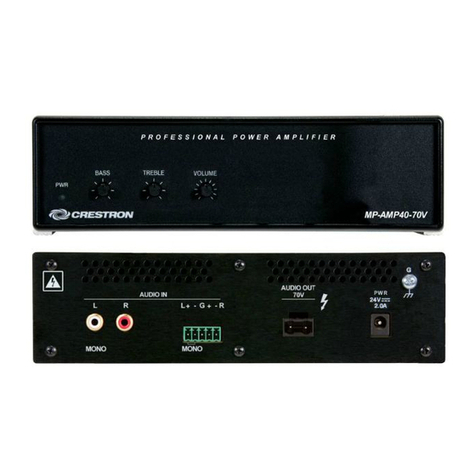
Crestron
Crestron MP-AMP40-70/100V Operations & installation guide

Philips
Philips FA761 Instructions for use
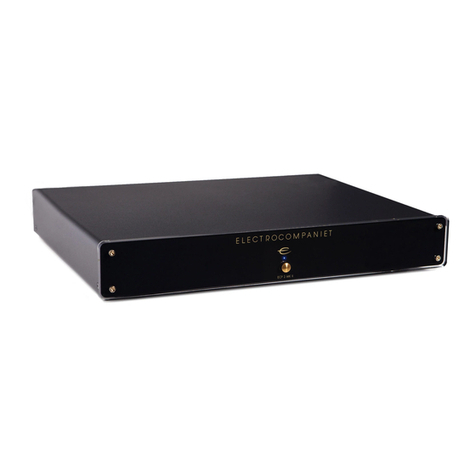
ELECTROCOMPANIET
ELECTROCOMPANIET ECP 2 MKII owner's manual

RedSeven Amplification
RedSeven Amplification The Dirt user manual
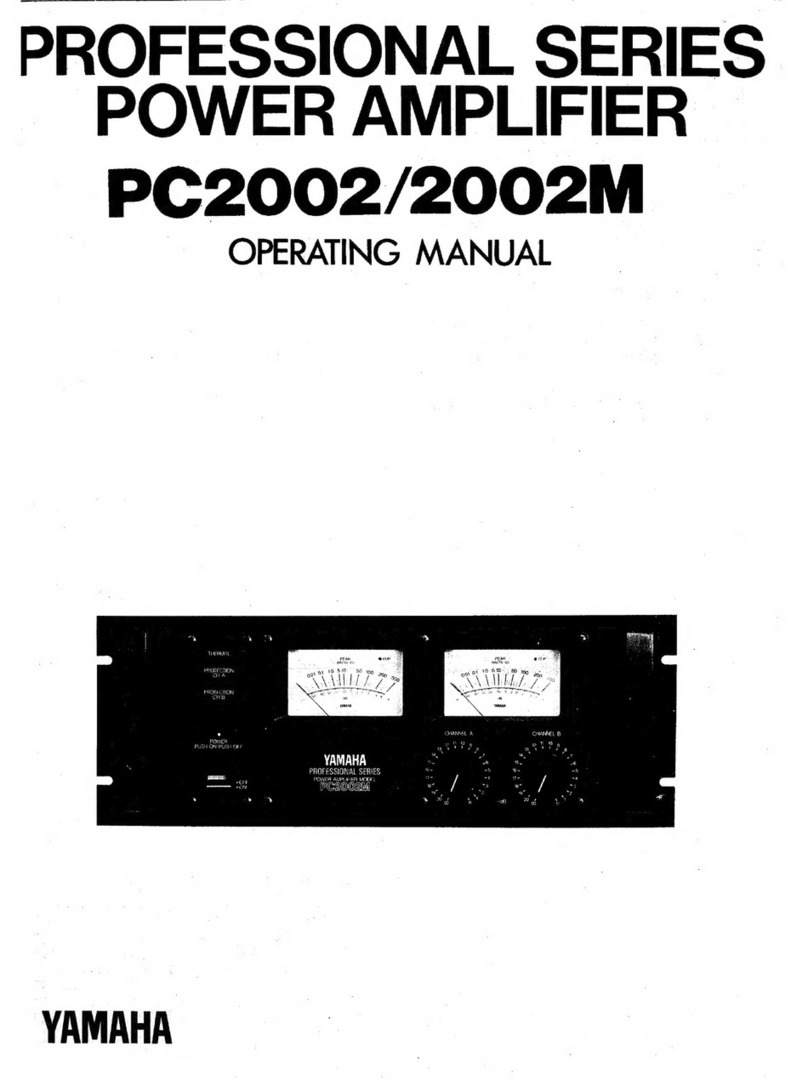
Yamaha
Yamaha PC2002 operating manual
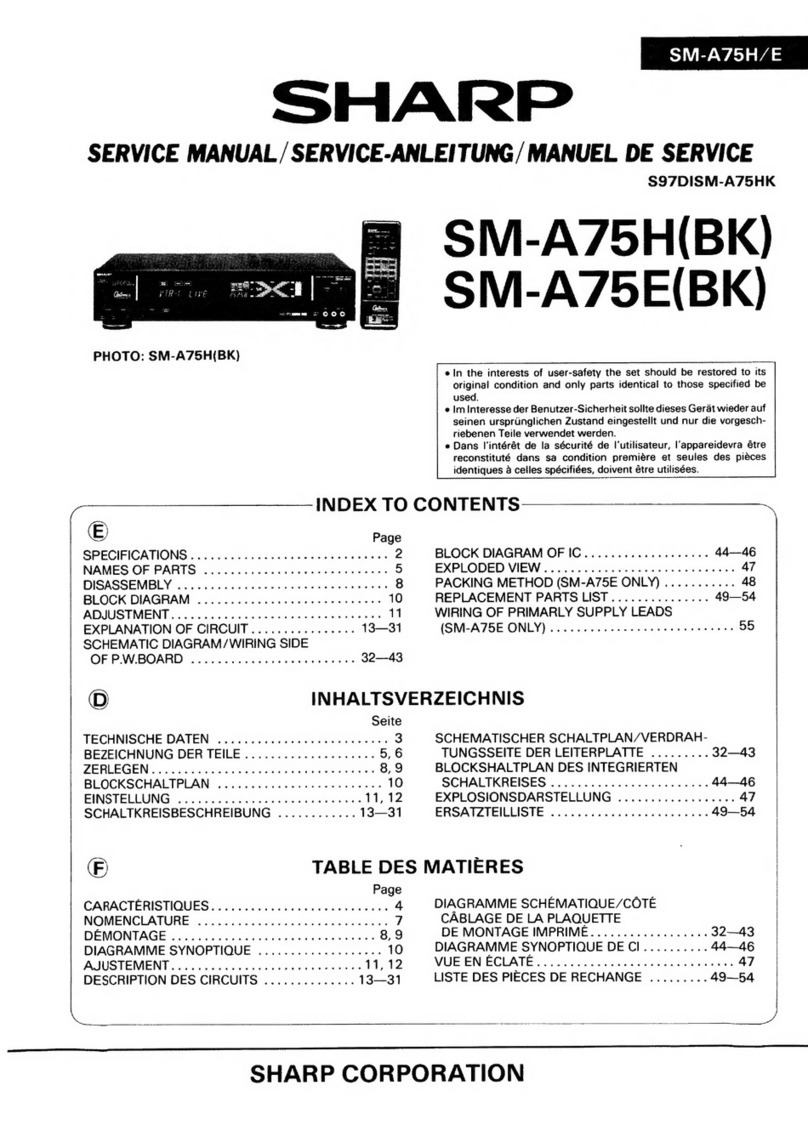
Sharp
Sharp SM-A75H(BK) Service manual
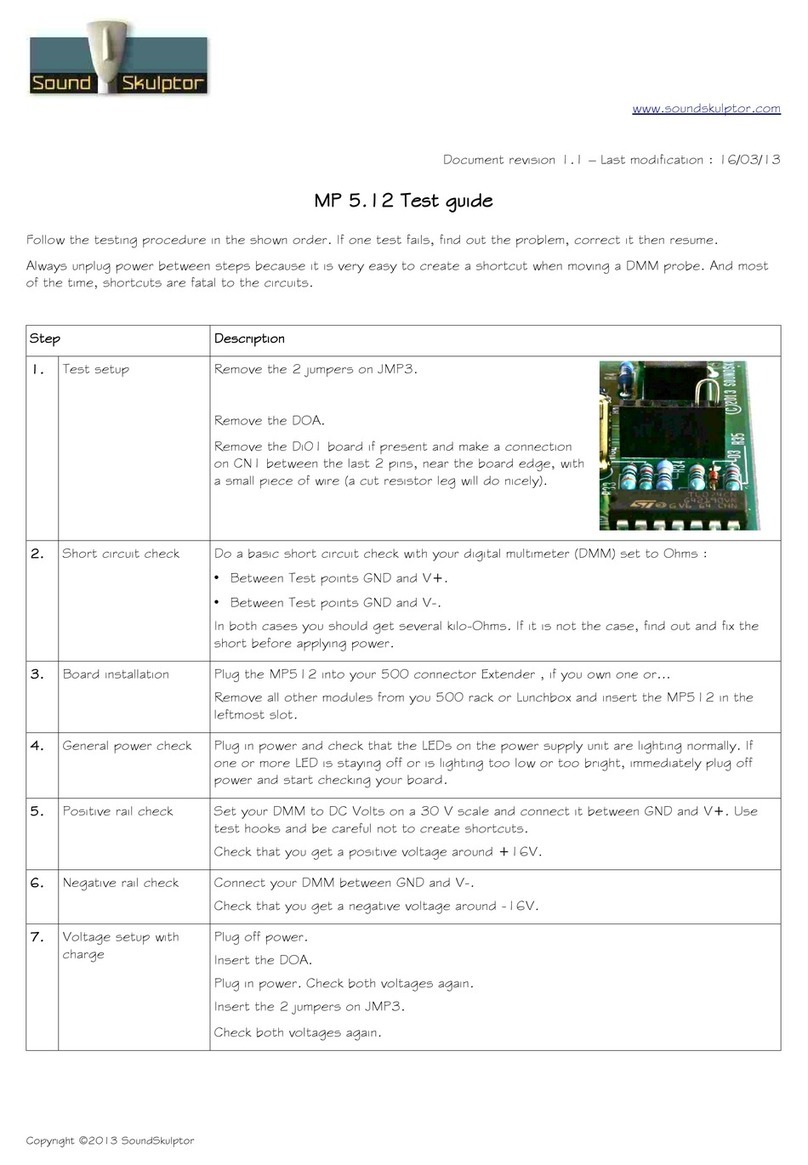
Sound Skulptor
Sound Skulptor MP 512 Test guide
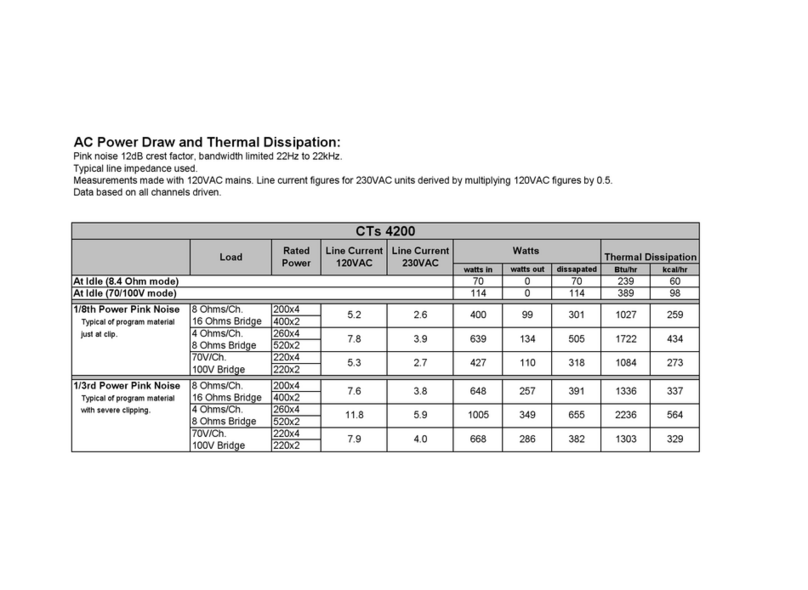
Crown
Crown CTs 4200 USP/CN Specifications
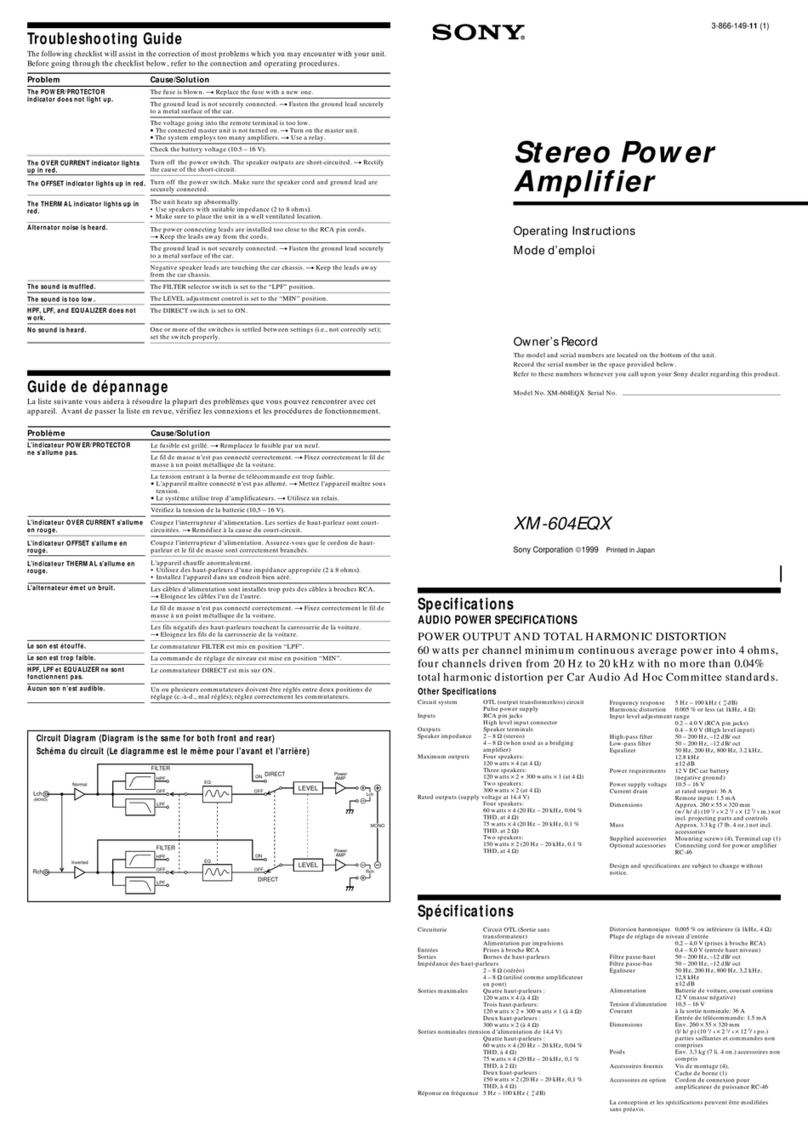
Sony
Sony XM-604EQX Marketing Specifications operating instructions
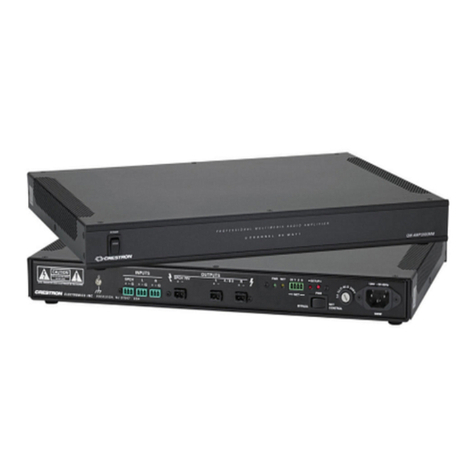
Crestron
Crestron QM-AMP3x80 Series Operation guide

Behringer
Behringer V-Tone Acoustic ADI 21 manual
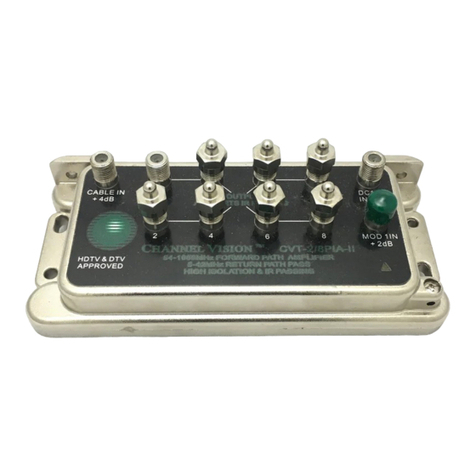
Channel Vision
Channel Vision CVT-2/8WB instructions
